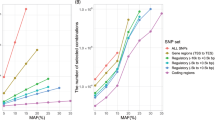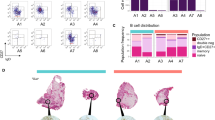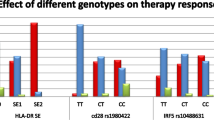Abstract
The butyrophilin-like protein 2 gene (BTNL2) within the class III region of the major histocompatibility complex genomic region was identified as a rheumatoid arthritis (RA) susceptibility gene by exome sequencing (19 RA cases) with stepwise filtering analysis, and then validated by Sanger sequencing and association analysis using 432 cases and 432 controls. Logistic regression of the Sanger-sequenced single-nucleotide variants in an association study of 432 cases and 432 controls showed that 12 non-synonymous single-nucleotide polymorphisms (SNPs) in BTNL2 were significantly associated with RA. The lowest P-values were obtained from three SNPs, rs41521946, rs28362677 and rs28362678, which were in absolute linkage disequilibrium: P=4.55E−09, odds ratio=1.88, 95% confidence interval=1.52–2.33. The BTNL2 locates on chromosome 6 between HLA-DRB1 and NOTCH4, and is 170 kb apart from these two genes. Although DRB1 and NOTCH4 were reported to be RA-susceptible, the three BTNL2 SNPs retained significant association with RA when evaluated by the logistic regression with the adjustment for RA-susceptible HLA-DRB1 alleles in Japanese or rs2071282-T in NOTCH4: P=0.0156 and P=0.00368, respectively. These results suggest that the three non-synonymous SNPs in BTNL2 confer RA risk independently from HLA-DRB1 and NOTCH4.
Similar content being viewed by others
Log in or create a free account to read this content
Gain free access to this article, as well as selected content from this journal and more on nature.com
or
References
MacGregor, A. J., Snieder, H., Rigby, A. S., Koskenvuo, M., Kaprio, J., Aho, K. et al. Characterizing the quantitative genetic contribution to rheumatoid arthritis using data from twins. Arthritis Rheum. 43, 30–37 (2000).
Deighton, C. M., Walker, D. J., Griffiths, I. D. & Roberts, D. F. The contribution of HLA to rheumatoid arthritis. Clin. Genet. 36, 178–182 (1989).
Wellcome Trust Case Control Consortium. Genome-wide association study of 14 000 cases of seven common diseases and 3000 shared controls. Nature 447, 661–678 (2007).
Wellcome Trust Case Control Consortium Craddock, N., Hurles, M. E., Cardin, N., Pearson, R. D., Plagnol, V. et al. Genome-wide association study of CNVs in 16000 cases of eight common diseases and 3000 shared controls. Nature 464, 713–720 (2010).
de Vries, R. Genetics of rheumatoid arthritis: time for a change!. Curr. Opin. Rheumatol. 23, 227–232 (2011).
Raychaudhuri, S., Remmers, E. F., Lee, A. T., Hackett, R., Guiducci, C., Burtt, N. P. et al. Common variants at CD40 and other loci confer risk of rheumatoid arthritis. Nat. Genet. 40, 1216–1223 (2008).
Manolio, T. A., Collins, F. S., Cox, N. J., Goldstein, D. B., Hindorff, L. A., Hunter, D. J. et al. Finding the missing heritability of complex diseases. Nature 461, 747–753 (2009).
McClellan, J. & King, M. C. Genetic heterogeneity in human disease. Cell 141, 210–217 (2010).
Zuk, O., Hechter, E., Sunyaev, S. R. & Lander, E. S. The mystery of missing heritability: genetic interactions create phantom heritability. Proc. Natl Acad. Sci. USA 109, 1193–1198 (2012).
Nejentsev, S., Walker, N., Riches, D., Egholm, M. & Todd, J. A. Rare variants of IFIH1, a gene implicated in antiviral responses, protect against type 1 diabetes. Science 324, 387–389 (2009).
Rivas, M. A., Beaudoin, M., Gardet, A., Stevens, C., Sharma, Y., Zhang, C. K. et al. Deep resequencing of GWAS loci identifies independent rare variants associated with inflammatory bowel disease. Nat. Genet. 43, 1066–1073 (2011).
Ng, S. B., Turner, E. H., Robertson, P. D., Flygare, S. D., Bigham, A. W., Lee, C. et al. Targeted capture and massively parallel sequencing of 12 human exomes. Nature 461, 272–276 (2009).
Ng, S. B., Buckingham, K. J., Lee, C., Bigham, A. W., Tabor, H. K., Dent, K. M. et al. Exome sequencing identifies the cause of a mendelian disorder. Nat. Genet. 42, 30–35 (2010).
Orozco, G., Eerligh, P., Sánchez, E., Zhernakova, S., Roep, B. O., González-Gay, M. A. et al. Analysis of a functional BTNL2 polymorphism in type 1 diabetes, rheumatoid arthritis, and systemic lupus erythematosus. Hum. Immunol. 66, 1235–1241 (2005).
Valentonyte, R., Hampe, J., Huse, K., Rosenstiel, P., Albrecht, M., Stenzel, A. et al. Sarcoidosis is associated with a truncating splice site mutation in BTNL2. Nat. Genet. 37, 357–364 (2005).
Rybicki, B. A., Walewski, J. L., Maliarik, M. J., Kian, H. & Iannuzzi, M. C., ACCESS Research Group The BTNL2 gene and sarcoidosis susceptibility in African Americans and Whites. Am. J. Hum. Genet. 77, 491–499 (2005).
Wijnen, P. A., Voorter, C. E., Nelemans, P. J., Verschakelen, J. A., Bekers, O. & Drent, M. Butyrophilin-like 2 in pulmonary sarcoidosis: a factor for susceptibility and progression? Hum. Immunol. 72, 342–347 (2011).
Pathan, S., Gowdy, R. E., Cooney, R., Beckly, J. B., Hancock, L., Guo, C. et al. Confirmation of the novel association at the BTNL2 locus with ulcerative colitis. Tissue Antigen 74, 322–329 (2009).
Hsueh, K. C., Lin, Y. J., Chang, J. S., Wan, L. & Tsai, F. J. BTNL2 gene polymorphisms may be associated with susceptibility to Kawasaki disease and formation of coronary artery lesions in Taiwanese children. Eur. J. Pediatr. 169, 713–719 (2010).
Nakajima, M., Takahashi, A., Kou, I., Rodriguez-Fontenla, C., Gomez-Reino, J. J., Furuichi, T. et al. New sequence variants in HLA class II/III region associated with susceptibility to knee osteoarthritis identified by genome-wide association study. PLoS One 5, e9723 (2010).
Valdes, A. M., Styrkarsdottir, U., Doherty, M., Morris, D. L., Mangino, M., Tamm, A. et al. Large scale replication study of the association between HLA class II/BTNL2 variants and osteoarthritis of the knee in European-descent populations. PLoS One 6, e23371 (2011).
Traherne, J. A., Barcellos, L. F., Sawcer, S. J., Compston, A., Ramsay, P. P., Hauser, S. L. et al. Association of the truncating splice site mutation in BTNL2 with multiple sclerosis is secondary to HLA-DRB1*15. Hum. Mol. Genet. 15, 155–161 (2006).
Simmonds, M. J., Heward, J. M., Barrett, J. C., Franklyn, J. A. & Gough, S. C. Association of the BTNL2 rs2076530 single nucleotide polymorphism with Graves’ disease appears to be secondary to DRB1 exon 2 position beta74. Clin. Endocrinol. 65, 429–432 (2006).
Johnson, C. M., Traherne, J. A., Jamieson, S. E., Tremelling, M., Bingham, S., Parkes, M. et al. Analysis of the BTNL2 truncating splice site mutation in tuberculosis, leprosy and Crohn’s disease. Tissue Antigen 69, 236–241 (2007).
Arnett, F. C., Edworthy, S. M., Bloch, D. A., McShane, D. J., Fries, J. F., Cooper, N. S. et al. The American Rheumatism Association 1987 revised criteria for the classification of rheumatoid arthritis. Arthritis Rheum. 31, 315–324 (1988).
Li, H. & Durbin, R. Fast and accurate short read alignment with Burrows-Wheeler transform. Bioinformatics 25, 754–760 (2009).
Li, H., Handsaker, B., Wysoker., A., Fennell, T., Ruan, J., Homer, N. et al. The Sequence Alignment/Map format and SAMtools. Bioinformatics 25, 2078–2079 (2009).
McKenna, A., Hanna, M., Banks, E., Sivachenko, A., Cibulskis, K., Kernytsky, A. et al. The Genome Analysis Toolkit: a MapReduce framework for analyzing next-generation DNA sequencing data. Genome. Res. 20, 1297–1303 (2010).
DePristo, M. A., Banks, E., Poplin, R., Garimella, K. V., Maguire, J. R., Hartl, C. et al. A framework for variation discovery and genotyping using next-generation DNA sequencing data. Nat. Genet. 43, 491–498 (2011).
Wang, K., Li, M. & Hakonarson, H. ANNOVAR: functional annotation of genetic variants from high-throughput sequencing data. Nucleic Acids Res. 38, e164 (2010).
Purcell, S., Neale, B., Todd-Brown, K., Thomas, L., Ferreira, M. A., Bender, D. et al. PLINK: a tool set for whole-genome association and population-based linkage analyses. Am. J. Hum. Genet. 81, 559–575 (2007).
Stephens, M. & Donnelly, P. A comparison of Bayesian methods for haplotype reconstruction from population genotype data. Am. J. Hum. Genet. 73, 1162–1169 (2003).
Barrett, J. C., Fry, B., Maller, J. & Daly, M. J. Haploview: analysis and visualization of LD and haplotype maps. Bioinformatics 21, 263–265 (2005).
Bansal, V., Libiger, O., Torkamani, A. & Schork, N. J. Statistical analysis strategies for association studies involving rare variants. Nat. Rev. Genet. 11, 773–785 (2010).
Tamiya, G., Shinya, M., Imanishi, T., Ikuta, T., Makino, S., Okamoto, K. et al. Whole genome association study of rheumatoid arthritis using 27039 microsatellites. Hum. Mol. Genet. 14, 2305–2321 (2005).
Mitsunaga, S., Suzuki, Y., Kuwana, M., Sato, S., Kaneko, Y., Homma, Y. et al. Associations between six classical HLA loci and rheumatoid arthritis: a comprehensive analysis. Tissue Antigen 80, 16–25 (2012).
Bang, M. L., Mudry, R. E., McElhinny, A. S., Trombitás, K., Geach, A. J., Yamasaki, R. et al. Myopalladin, a novel 145-kilodalton sarcomeric protein with multiple roles in Z-disc and I-band protein assemblies. J. Cell. Biol. 153, 413–427 (2001).
Miller, M. K., Bang, M. L., Witt, C. C., Labeit, D., Trombitas, C., Watanabe, K. et al. The muscle ankyrin repeat proteins: CARP, ankrd2/Arpp and DARP as a family of titin filament-based stress response molecules. J. Mol. Biol. 333, 951–964 (2003).
Arnett, H. A., Escobar, S. S., Gonzalez-Suarez, E., Budelsky, A. L., Steffen, L. A., Boiani, N. et al. BTNL2, a butyrophilin/B7-like molecule, is a negative costimulatory molecule modulated in intestinal inflammation. J. Immunol. 178, 1523–1533 (2007).
Nguyen, T., Liu, X. K., Zhang, Y. & Dong, C. BTNL2, a butyrophilin-like molecule that functions to inhibit T cell activation. J. Immunol. 176, 7354–7360 (2006).
Gregersen, P. K., Amos, C. I., Lee, A. T., Lu, Y., Remmers, E. F., Kastner, D. L. et al. REL, encoding a member of the NF-kappaB family of transcription factors, is a newly defined risk locus for rheumatoid arthritis. Nat. Genet. 41, 820–823 (2009).
Stahl, E. A., Raychaudhuri, S., Remmers, E. F., Xie, G., Eyre, S., Thomson, B. P. et al. Genome-wide association study meta-analysis identifies seven new rheumatoid arthritis risk loci. Nat. Genet. 42, 508–514 (2010).
Cui, J., Taylor, K. E., Destefano, A. L., Criswell, L. A., Izmailova, E. S., Parker, A. et al. Genome-wide association study of determinants of anti-cyclic citrullinated peptide antibody titer in adults with rheumatoid arthritis. Mol. Med. 15, 136–143 (2009).
Acknowledgements
We thank the DNA donors and supporting medical staff for making this study possible. We thank Miyako Nakagawa and Tomomi Ito (Division of Rheumatology, Tokai University School of Medicine), Hisako Kawata, Masayuki Tanaka and Hideki Hayashi (Education and Research Support Center, Tokai University School of Medicine) for their excellent technical assistance. We also thank Dr Atsushi Toyoda (Comparative Genomics Laboratory, National Institute of Genetics), Dr Shoji Tsuji, Dr Jun Mitsui and Dr Hiroyuki Ishiura (Department of Neurology, Division of Neuroscience, Graduate School of Medicine, The University of Tokyo), Dr Shinichi Morishita and Dr Jun Yoshimura (Department of Computational Biology, Graduate School of Frontier Sciences, The University of Tokyo) for their supporting based on the Grant in-Aid-for Scientific Research on Innovative Areas ‘Genome Science’ (No.221S0002) from the Ministry of Education, Culture, Sports, Science and Technology of Japan. This work was supported in part by a Grant-in-Aid for Scientific Research (C) (No. 22510213) and a Grant-in-Aid for Scientific Research from the Japanese Ministry of Health, Labor, and Welfare.
Author information
Authors and Affiliations
Corresponding author
Ethics declarations
Competing interests
The authors declare no conflict of interest.
Additional information
Supplementary Information accompanies the paper on Journal of Human Genetics website
Supplementary information
Rights and permissions
About this article
Cite this article
Mitsunaga, S., Hosomichi, K., Okudaira, Y. et al. Exome sequencing identifies novel rheumatoid arthritis-susceptible variants in the BTNL2. J Hum Genet 58, 210–215 (2013). https://doi.org/10.1038/jhg.2013.2
Received:
Revised:
Accepted:
Published:
Issue date:
DOI: https://doi.org/10.1038/jhg.2013.2
Keywords
This article is cited by
-
First-appearing islet autoantibodies for type 1 diabetes in young children: maternal life events during pregnancy and the child’s genetic risk
Diabetologia (2021)
-
The ontogeny of Butyrophilin-like (Btnl) 1 and Btnl6 in murine small intestine
Scientific Reports (2016)
-
Immune modulation by butyrophilins
Nature Reviews Immunology (2014)



